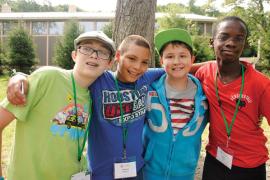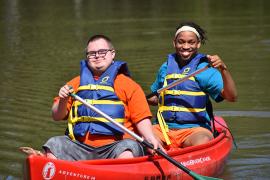The death of a loved one is a reality that each of us must face at some point. The experience of a loss invokes a myriad of feelings for adults and children alike. Some will maintain the belief that children are oblivious to the grief experience. Of course, this is not the case. Children are all too aware of the feelings and thoughts that follow the death of a loved one. Like adults, children need outlets in which to safely express the feelings associated with their loss.
This is where Camp El Tesoro de la Vida ("The Treasure of Life") has excelled for almost twenty years. This camp provides an experience that is 90 percent camp activities like horseback riding, archery, hiking, arts and crafts, canoeing, and swimming and 10 percent therapeutic activities designed to assist a child through the grief process. Accredited by the American Camp Association, Camp El Tesoro is owned and operated by Camp Fire USA First Texas Council. Located approximately forty-five minutes from Fort Worth in Granbury, Texas, El Tesoro hosts a variety of camp experiences throughout the year including children's summer resident camps (Camp Fire USA First Texas Council, 2006).
Camp El Tesoro de la Vida is a one-week resident camp experience for children ages six to seventeen who are grieving the death of a loved one. The basic requirement for admission into camp is that a child has lost someone that he or she loves (Camp Fire USA First Texas Council, 1988). Each summer, typically in the final week of July, families from surrounding Texas cities (and sometimes more distant locales) bring their children to the campground for a week of fun and remembrance.
History
In mid-1987, Camp Fire USA First Texas Council called together a small group of professionals to brainstorm the possibility of developing a camp that would provide an experience for children mourning the death of a loved one. After several meetings which included consulting with a local camp for children with cancer, Compassionate Friends, and a Camp Fire USA organization in the state of Washington that offered a similar program, the group proceeded to search for a chairperson for the camp and, of course, a name.
The name, El Tesoro de la Vida, suggested by the Camp Fire public relations staff, was approved by the committee at its second meeting. At that same time, the premise for this pilot camp was developed:
- The camp would be five days in length (July 30 - August 4, 1988).
- The initial camp would serve approximately fifty children ages six to sixteen.
- The camp would be 90 percent traditional camp activities and 10 percent "nurturing back to a normal life."
- Attending children would have lost a loved one by means of death.
- If possible, the camp would be free to attending children.
- The importance of some form of follow-up program was stressed.
As the year proceeded, the Camp Fire Camping Committee chose the camp staff and a local philanthropic organization was contacted to provide volunteers. In December of 1987, the Board of Directors for Camp Fire agreed that plans for the camp should proceed, and on July 30, 1988, the first season of Camp El Tesoro de la Vida was underway.
The Application Process
Before a child actually attends Camp El Tesoro de la Vida, a series of events take place. To begin, the child's caregiver(s) must complete an application to attend the camp. Upon receiving the applications, Camp Fire personnel carefully sort and distribute the applications to the five individuals who serve as therapists for the one-week camp. Approximately four months before the start of camp, each of the members of the therapeutic staff digests information contained in applications and interviews parents and/or caregivers. After the child is approved to attend, Camp Fire mails a confirmation packet to the family.
Program Description
Day One
Campers and parents proceed through the check-in process on a late Sunday. Typically, families report to the camp at approximately 3:00 p.m. This is often a homecoming of sorts for those campers who attended one or even two years before. All camp staff is on hand to facilitate the various stages of check-in.
Windsocks hang from trees above benches where children report to their counselors and fellow campers. Each windsock represents the age and gender-appropriate cabin where campers stay. For example, the "Kittens" is the youngest female cabin, while the "Coyotes" is the oldest male cabin. Approximately six to eight children are assigned to each cabin.
After dinner, everyone gathers as a whole. At this time, the concepts of death, grief, and mourning are discussed. This is also the first time campers are exposed to singing songs that are treasured at Camp El Tesoro de la Vida. For many of the campers, this may be the first time open discussion of death and bereavement has taken place.
Days Two through Six
Each of the next five days is unique. However, there are certain consistencies. Breakfast is usually served at 7:30 a.m. preceded by grace. After breakfast is served, a cabin is assigned the duty of raising the flag. At the conclusion of the flag raising, campers proceed to their daily activities as the camp staff sends them off with a morning rendition of "It's a Grand Old Flag." By 8:30 a.m. each camper is participating in the day's first activity.
The mornings are filled with scheduled activities for campers. Children attend a variety of activities including horseback riding, arts and crafts, canoeing, archery, and creek walking to name a few. Each cabin also comes together at a designated time to participate in one hour of group therapy. In group therapy, campers are encouraged to share their experiences and participate in activities designed to facilitate the grief process. Each of the groups is, of course, homogeneous in age and gender (since the participants of each group are also in the same cabins).
Lunchtime immediately follows the morning's activities. At the conclusion of lunch, a couple of camp staff members play guitars and lead campers in camp songs. At the conclusion of lunch, time is spent cleaning cabins, resting, and playing games around the campgrounds.
After dinner, camp songs are sung and then the evening activities begin. Camp activities are different each night and vary from year to year — although some remain consistent each year. Rodeo night has become a camper favorite. The rest of the week's evening activities include a movie night, a special event called "pig out," and a dance.
The final evening begins with a large group closing activity. At the conclusion of this, each therapist facilitates a more intimate closing activity for each of his or her respective groups. Typically some form of memorial occurs for those who have died. Children from six to seventeen seem to understand the significance of the event. For some children, this activity is the crescendo of an emotion-filled week.
Day Seven
At the conclusion of breakfast, campers pack their gear and clean their cabins. By 10 a.m. that morning, family and close friends of all attending children will have gathered at the camp chapel for the closing ceremony. Shortly after all families have gathered in the chapel, the sound of children singing can be heard throughout the surrounding woods. In single file, the campers make their way to the chapel singing "Follow Me." They file into the first few rows and the camp volunteer director begins the morning ceremony.
The presentation includes select campers performing songs, archery achievement awards being distributed, and thanks and recognition to various contributors to the camp. The morning concludes with a tree being planted in memory of those who have been lost. After the tree is placed in the ground, each of the campers by group will place a painted rock at the base of the tree in remembrance of the loved one who died. At this point, it is time for campers to return to their families. Family members may talk with cabin buddies while campers and staff exchange hugs and farewells. At this point, Camp El Tesoro de la Vida is officially concluded.
Research
In order to assess the impact of the camp on the participants, parents completed a questionnaire. Parents of the campers were asked about their children's behavior prior to and after the camp. Every parent of a child attending the camp was surveyed. According to the parents who returned questionnaires, the average age of attending children in the current study was thirteen years old, and seventh grade was the median grade of participants.
Because many parents who bring their children to the camp are concerned about their children's adjustment to their loss, the questionnaire focused primarily on issues related to coping with loss such as separation anxiety, interaction with peers and siblings, and the ability to work and play alone. Parents were asked if their children experienced anxiety in separating from parents. There was a statistically significant difference between parents' perception of children's anxiety prior to and after the camp. In addition, parents were asked about how their children played with other children and how they worked alone. A statistically significant difference was found between parents' perception of children's ability to play and work alone prior to and after the camp.
Though these results were exploratory and the sample size (n = 26) was small, the findings provided support that the camp is effective in addressing some of the primary concerns of parents.
Camp El Tesoro de la Vida is a special and meaningful camp experience for children grieving the death of a loved one. Because of the unique qualities fundamental to this program—caring volunteers and staff, meaningful symbols, poignant traditions, and sensitive therapy—children were significantly helped through a very difficult time in their lives.
Acknowledgments
The authors wish to thank Zem Neill, Lisa Cook, Lydia Goetz, Sheri Willis, Dana Minor, and Denis Cranford. Without the input of these helpful and caring individuals, this article could not have been completed.
References
Camp Fire USA (n.d.). Retrieved December 16, 2006 from http://www.firsttexascampfire.org/Camp/delaVida.htm.
Camp Fire USA (1988). Report of camp el tesoro de la vida proceedings. Fort Worth, TX.
Chris Simpson, Ph.D., is an assistant professor of counseling at Texas A&M University-Commerce and a licensed professional counselor in Dallas, Texas. For the past seven years, Dr. Simpson has been a therapist for Camp El Tesoro de la Vida.
Stephen A. Armstrong, Ph.D., is an assistant professor of counseling at Texas A&M University-Commerce and a licensed professional counselor, board-approved supervisor. His specialties include play therapy, group therapy, and supervision.
Originally published in the 2007 July/August issue of Camping Magazine.


